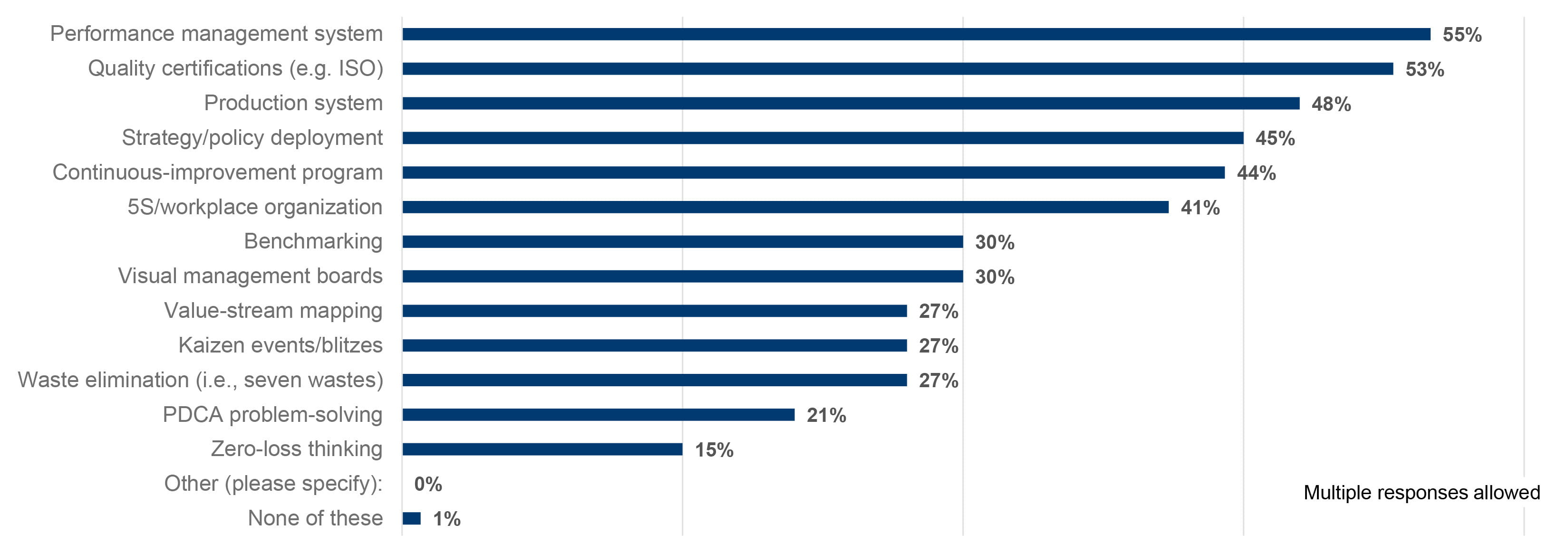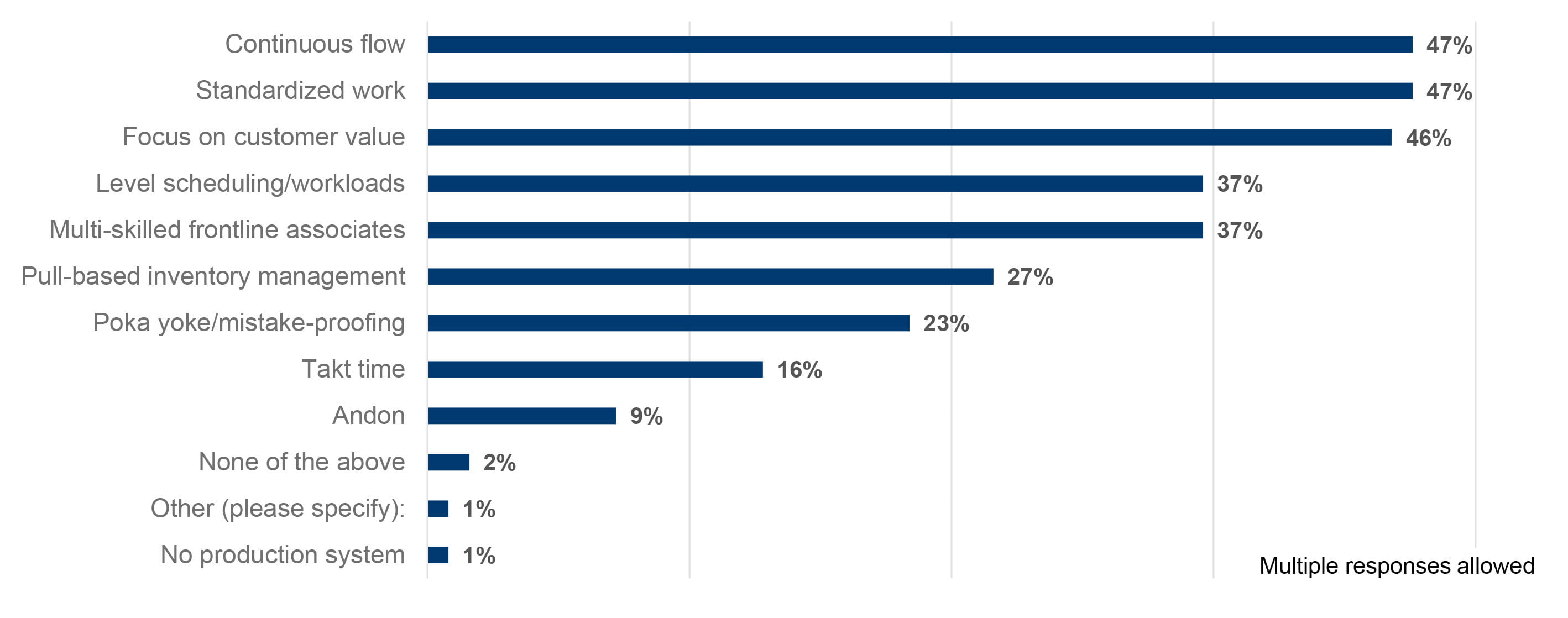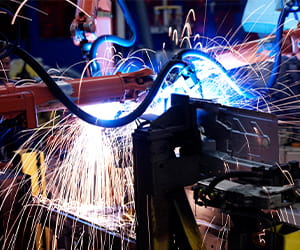Difficult economic conditions give manufacturers opportunities to increase equity value

In today’s challenging economic environment, manufacturers face significant pressure to reduce operational costs while also improving performance by increasing revenue and EBITDA to achieve an overall improvement in equity value.
In this article, we will explore some of the ways manufacturers can use performance improvement initiatives to increase a company’s overall earnings and equity value using key data derived from the CohnReznick Manufacturing Checkup Survey that asked 172 U.S. manufacturing executives to assess the efficiency and effectiveness of corporate functions critical to profitable performance of their business. The survey included a diverse set of industrial firms, both private and public.
Don’t underestimate the power of financial modeling
Financial models are a structured representation of your business strategy and they are often the first step towards performance improvement. The goal of modeling is to accurately project a manufacturer’s future financial performance based on the impact of various strategic and operational decisions. They are used inside and outside the manufacturer to improve decision-making and forecasting around variable and fixed costs absorption, inventory costing and management, gross margin dilution, capital allocation, strategic investments, and cash management including fundraising.
Utilize sales and operations planning to optimize your business
Sales and operations planning (S&OP) is another key process that can help improve business operations. S&OP is a management process used to develop a unified plan for meeting customer demand by aligning sales, marketing, finance, and operations processes and teams. It includes demand planning, procurement and supply planning, inventory management, and production planning. The goal is to help ensure the manufacturer’s primary assets, people, materials, and equipment are effectively utilized to meet customer demand while minimizing cost and maximizing profitability, cash flow, and ultimately enterprise value.
According to the CohnReznick Manufacturing Checkup Survey, one-fifth of manufacturers report challenges with enterprise planning and forecasting. To implement S&OP, management should try to ensure inputs and outputs align across sales forecasts, production plans, and financial budgets. It also requires an increase in communication and alignment across sales, marketing, finance, and operational departments to enable data-driven decision-making among the key stakeholders. Once completed, the S&OP, along with the financial model, should allow management to better balance supply and demand across product lines.
Hone-in on key performance indicators
Another critical step to improve operations is to establish key performance indicators (KPIs). The best KPIs are leading metrics that provide early warnings of problems that may harm your bottom line. KPIs can also lead management to focus in on areas for continuous improvement.
Common KPIs used by businesses include:
- Safety: Near-miss incidents are one of the leading KPIs that provides insight into potential hazards and allows the manufacturer to take corrective action as well as manage costs associated with poor safety such as high workers compensation premiums, potential fines, or penalties.
- Quality: Tracking scrap and rework rates helps enable a manufacturer to get to the root cause of an issue faster. By identifying and fixing the problem, the manufacturer can reduce inventory costs, improve product quality, and increase production capacity.
- Speed: Tracking machine production capabilities can help a manufacturer improve utilization capacity, lower costs, and reduce waste.
- Cost: Cost KPIs that track overtime costs, or the number of expedited shipments for customer orders, can serve as a warning sign of scheduling, production, and management issues.
- Total performance: Total performance KPIs, such as overall equipment effectiveness (OEE), allows a manufacturer to gain further insight into its machines as well as its plant’s overall productivity.
Make continuous improvement part of your culture
Continuous improvement is a common term that many managers want to achieve but are not sure how to do it. First, it should be thought of as the manufacturer’s culture and philosophy, not a project. It seeks to improve every process in your business by focusing on enhancing the activities that generate the most value for your customer while removing as many wasteful activities as possible. In the CohnReznick Manufacturing Checkup survey, we found that (Figure 1):
- Approximately 55% of respondents are using a type of performance management system or quality certification to improve operations
- Approximately one-third of respondents were using benchmarking, visual management boards, or value-stream mapping resources
Figure 1. Programs and/or practices in place to drive continuous improvement (% of manufacturers)
There are several different methods that are used to achieve continuous improvement programs including Lean and Six Sigma. A business has the opportunity to expand capacity through reorganization of plant equipment and/or production schedules to increase equipment optimization and efficiencies.
As a manufacturer considers ways to implement continuous improvement into daily operations, the use of technology should also be considered. Technology can automate processes, reduce errors, improve quality, and enhance communication among various departments.

Lean-based production
The CohnReznick Manufacturing Checkup Survey also highlighted that approximately half of the manufacturers surveyed utilize lean-based production principals (Figure 2) which indicates a large opportunity for improved efficiencies that can immediately impact your bottom line. Lean-based production principals can help to boost innovation, cut costs, eliminate waste, and optimize production processes.
Figure 2. Lean-based production principles used to increase efficiencies and drive value for customers (% of manufacturers)
Examples of lean-based production principles include:
- Continuous flow: Movement of a product one unit at a time to minimize inventory, reduce production time, and minimize quality problems.
- Standardized work: Precise instructions for how to perform work in the most efficient and safe manner.
- Customer value: Eliminating all work (and associated costs) that customers do not perceive as value-added.

Skilled and motivated workforce
A stable, engaged, educated, and empowered workforce is another prominent driver of success that can help to increase efficiencies and reduce costs. By investing in training and development, employees are more likely to increase productivity, reduce errors, and improve quality. Additionally, by educating and empowering employees to speak up, a manufacturer can experience enhanced innovation from the employees mastering the production process.
The use of technology is also an important factor here. The use of technology helps make a manufacturer’s workplace more desirable. This, in turn, helps attract and retain employees, especially younger workers who are more familiar and comfortable with technology.
Manufacturers may need to invest in talent, and pay more competitive wages and benefits, but any increased costs are offset by lower employee turnover, and less usage of unskilled and/or temporary labor to meet customer demand.
Conclusion
Manufacturers have ample opportunities to improve their operations, earnings, and equity value in this current market, and often it takes an outside perspective with a fresh set of eyes to identify potential areas of opportunity. CohnReznick has assisted many manufacturing clients implement best practices and performance improvement programs to help reduce costs and increase equity value. Let us help you too.
Contact
Helana Robbins Huddleston, CPA, CIRA, Partner, Manufacturing and Distribution Industry – Co-Leader Transaction Advisory Services
312.508.5813
Contact
Let’s start a conversation about your company’s strategic goals and vision for the future.
Please fill all required fields*
Please verify your information and check to see if all require fields have been filled in.

CohnReznick Manufacturing Checkup Survey
This has been prepared for information purposes and general guidance only and does not constitute legal or professional advice. You should not act upon the information contained in this publication without obtaining specific professional advice. No representation or warranty (express or implied) is made as to the accuracy or completeness of the information contained in this publication, and CohnReznick, its partners, employees and agents accept no liability, and disclaim all responsibility, for the consequences of you or anyone else acting, or refraining to act, in reliance on the information contained in this publication or for any decision based on it.











